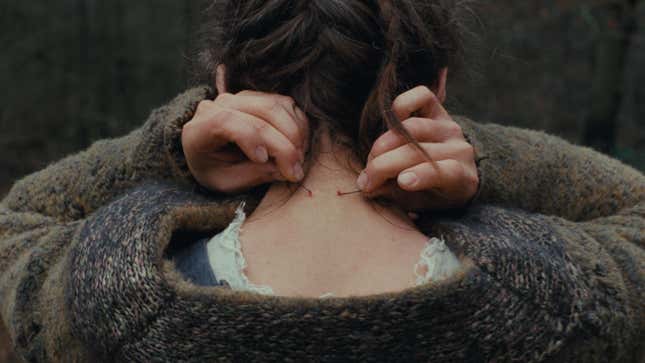
Austrian gloom purveyors Veronika Franz and Severin Fiala are no strangers to masochistically bleak approaches. The Devil’s Bath matches an underlying darkness present in their previous films Goodnight Mommy and The Lodge, like a specter breathing down your neck—but their new film’s historical context adds an inhumane sting. Franz and Fiala are indebted to Kathy Stuart’s research on 17th and 18th-century “suicide by proxy” cases in German-speaking Central Europe and Scandinavia, basing their protagonist on convicted peasant Eva Lizlfellnerin (1736–1762). The storytelling exhumes skeletons long buried in Austrian history books for a nationalistic brand of societal horrors, matching the introspective agony of Jennifer Kent’s The Nightingale. The Devil’s Bath is a time capsule stuffed with grief and despair, but at precisely two hours, its grueling “Horror Movie Social Studies” methods can feel maddening to a fault.
Musician Anja Plaschg stars as newlywed Agnes, who we meet all smiles, celebrating with her husband Wolf (David Scheid). They settle into a marital routine common in the 1700s, where Agnes is boxed in as a housewife who should tend to stables, prepare meals, and fulfill “womanly” duties. Wedded bliss quickly fades when Wolf’s mother, Gänglin (Maria Hofstätter), harshly criticizes Agnes’ abilities to carry out these predetermined roles, and she feels ostracized in her own home. Anges is visibly unwell, both mentally and physically, but she’s forced to uphold her status in the village, in her partnership, and as one of God’s children. Whether it’s depression or Satan holding Agnes in its clutches, it doesn’t matter—there is no escape.
The Devil’s Bath operates according to the tenets of folkloric horror, but doesn’t feature anything remotely fantastical outside Agnes’ fever dreams. Whereas Robert Eggers’ The Witch molds olden tales of oppressively religious teachings into outright horror imagery, The Devil’s Bath remains grounded and earthly. Franz and Fiala want Agnes’ journey to be comprehensible by modern mental health standards, drawing tension from civilizations where depressive feelings begot mistreatment and blasphemy. Agnes is abused, controlled, and stripped of any autonomy—that’s what’s terrifying. What’s depicted is how countless women in the 1700s lived then died, and The Devil’s Bath is an achingly traumatic examination of the lengths sufferers like Agnes and Eva would go to escape.
Franz and Fiala generate atmosphere and tone with soul-crushing moodiness to spare. Lower Austrian forests and Neuenburg castle ruins compose a mossy, boggy landscape that’s so hopelessly isolating outside the few farmhouses where villagers reside, creating open terrain where Agnes can wander. Plaschg doesn’t waste her surroundings as she spirals deeper into mania, finding hollowed-out hideaways in the terrain where she can curl in the fetal position, nestling close to Mother Nature, away from people. The musician-turned-actress allows her psyche to slip into an almost comatose delirium, detaching from existence like Agnes’ spirit has been sucked out with a vacuum. Plaschg keeps us watching as she explores the surrounding woodlands, seeking refuge from her demons, aided by an original score—from Plaschg—that unsettlingly rubs strings and plucks notes.
The problem becomes, as Agnes steadily decays, that the passion behind Franz and Fiala’s intentions turns The Devil’s Bath into a marathon endurance test. The narrative duplicates the pace with which Agnes trudges through shin-high mud, as historical reverence tries to double-dip as folkloric horror chills. It’s a suffocating, arduous task that subjects viewers to barbaric 1700s traditions involving festering wounds as healing treatments and doled justice through beheadings. It all dries out, and becomes brittle. The filmmakers adore the artistry behind slow-burn breakdowns, and while the real-world implications are downright damning, our time spent with Agnes diminishes by the end. Though it tells a cyclical story that explains an introductory atrocity through Agnes’ experiences, it’s far more linear than expected, leaving a disappointing aftertaste.
To everyone’s credit, The Devil’s Bath is a successfully morbid and unforgiving period psychodrama that will make you feel like utter garbage (on purpose). Franz and Fiala are their signature selves, but it’s my least favorite of their works thus far. Mileage will vary, dictated by your appreciation for methodical avalanches of sorrow driven by puritanical pressures. Everything is minimalistic, punctuated by the devastating context found in the research that helped shape Franz and Fiala’s screenplay. Some viewers will recognize dedication, others will have their patience tested. That’s not all that different from Goodnight Mommy or The Lodge, although the duo’s formula hasn’t yet been this unbalanced and sluggish.